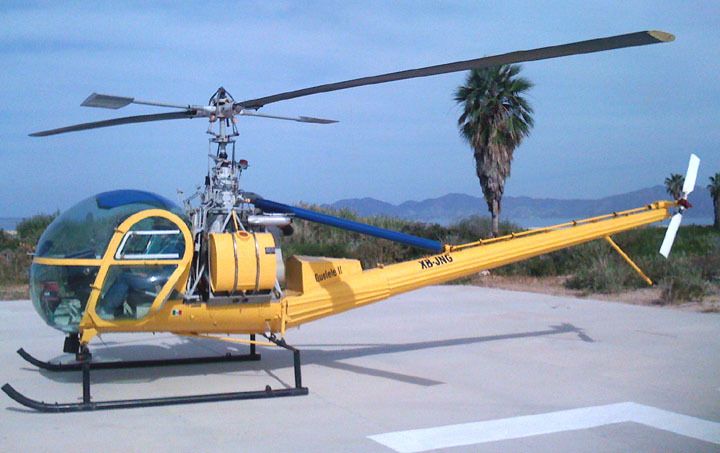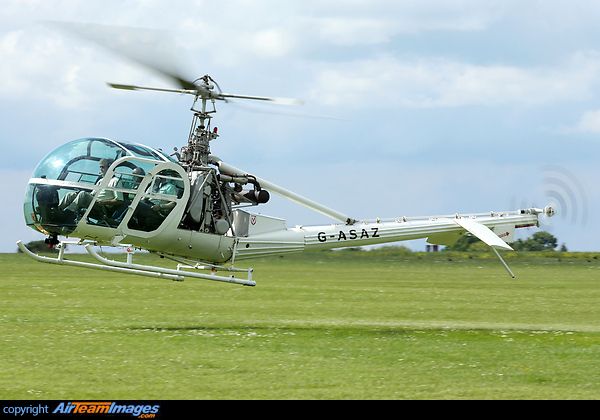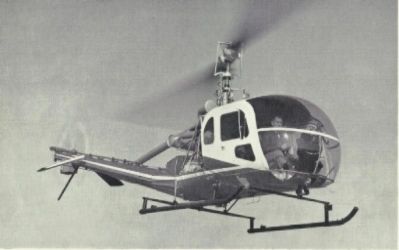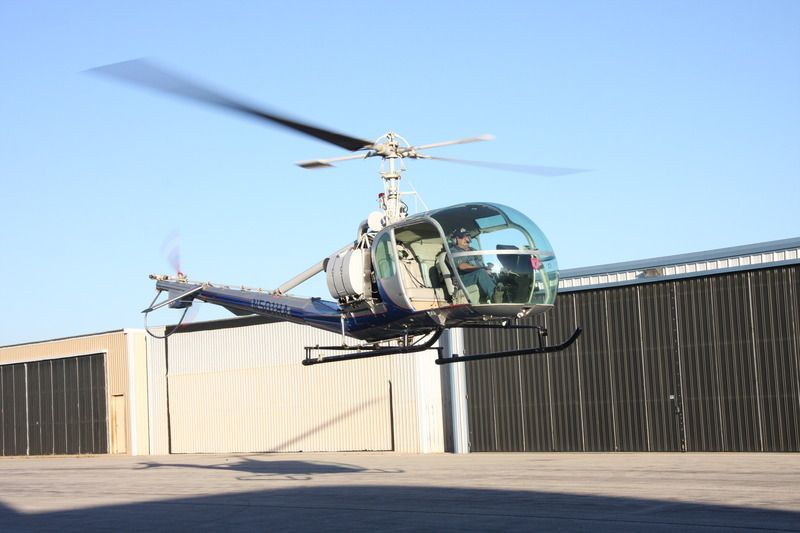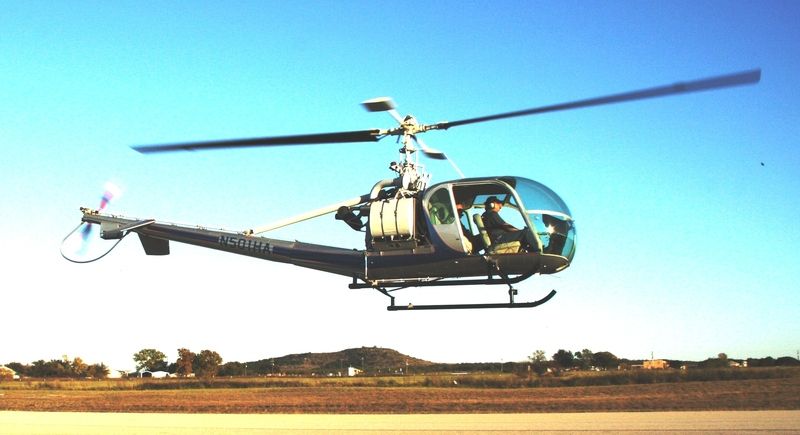In my last installment, I was in Texas visiting with my friend and presidential hopeful, Russell Madden who owns (among other things) an immaculate Hiller UH-12E helicopter. Unbeknownst to me, his friend, Pat Pockrus (who owns Ft. Wolters Helicopters) keeps a very rare four-seat model UH-12E4 in one of Russell’s hangars. When we started talking about going flying, I assumed it would be in the 12E. But the question was posed: Did I want to fly the three-seater or the four-seater? Whaaaaaat? This was intriguing and tantalizing! It kind of caught me by surprise. To explain why, you’ll have to indulge me in a little helicopter history.
Beginning in 1948, Stanley Hiller’s company in Palo Alto, California produced a tough, durable piston-engine helicopter called the model UH-12 (military model OH-23). He sold thousands of them to the U.S. military (mainly the Army), used it mainly as a trainer, but also as an observation/medical evacuation helicopter in Korea and beyond.
By the late 1950s and into the 1960s the military contracts for Hiller’s basic model trainer were coming to an end. However the UH-12 was also popular as a civilian helicopter too. In the Utility sector, the latest model, the 12E was earning a solid reputation as a real tough workhorse, rivaling the iconic Bell 47 in terms of durability and lifting capability. Over 3,000 Hiller model 12's have been built.
The Hiller UH-12E is a three-seater. Needing a bigger, four-seat model for the civilian market, Hiller stretched the cabin and stuck the pilot out in front-center, leaving the bench for three passengers behind. Initially, the model UH-12E4 as it was called looked very much like a regular mode 12E but with a double-bubble. It was kind of awkward and ungainly looking. I'll stop short of calling it ugly, but you decide.
Here's a standard Hiller 12E
And here's the original UH-12E4 coming in for a landing. Like I said...odd-looking
Stanley Hiller sold his company in 1964. Production of the civilian model 12 continued on for a while, but the new owners of the model line struggled to compete with the ubiquitous Bell 47 (Bell had a better marketing/sales force). In the mid-1960s, Hiller engineers introduced the improved model UH-12L4 with a more modern cabin for the four-seat machine. Very, very few of these still exist. Pat Pockrus has three. One of them is based in Russell’s hangar. So did I want to fly it? Hell, yeah!
Here's the newer, improved-er 12L4. Much more attractive to my eye
Late in the afternoon we went out to the Possum Kingdom airport. It was clear but very blustery. Not a great day to make friends with an unfamiliar helicopter. I worried that it might be too gusty for me to get a true feel for the ship. It’s not fun to be in a new-to-me aircraft when you have to fight the controls all the time. I didn't want to look bad. Nevertheless, Russell and Pat assured me it’d be fine.
N501HA is a beautiful machine. It looks brand-new. As sometimes happens with old helicopters, this one has been modified over the years. It started life as a UH-12E4, was used as a factory testbed for certain things, and ended up in the UH-12L4 cabin configuration.
We preflighted the ship and pulled it out onto the ramp. Pat guided me through the starting procedure. I was trying to concentrate, but in my excited mind I felt like a kid getting to drive dad’s vintage Corvette for the first time - the one with the big block engine and four-speed tranny and I've never driven a clutch before. And dad's sitting right next to me.
Hiller helicopters are…strange. Different. Helicopters have no built-in stability like a fixed-wing aircraft does. If you take your hands off the controls of a helicopter, it will quickly try to turn itself upside down. Stanley Hiller tried hard to remedy that. But in doing so he created another problem.
Without getting overly technical, Hiller’s solution was to design a rotor which was controlled by small paddles. Instead of a direct linkage from the control stick to the rotor blades (as in the Bell, Sikorsky and virtually every other helicopter in existence), the control stick in the Hiller was connected to small paddles that stuck out from the rotor hub at a ninety degree angle to the blades. The pilot controls the paddles and the paddles control the rotor.
The theory was that the short, fat paddles were more stable than those long, skinny and slender rotor blades. Which was mostly true. The Hiller 12 is a marvelously stable helicopter in both the hover and forward flight. There is a (in)famous picture – an air-to-air shot of an early model Hiller flying along high over San Francisco Bay. Both pilots are outside of the helicopter, crouching on the engine deck and
there is nobody at the controls! Bigger balls than I’ve got!
Look ma, no hands! And if you look closely, no pilots either.
However, as stable as the Hiller is, there’s this other problem I mentioned. All helicopter rotors act like a big gyroscope. A force acting at any given point on a gyro ring result in the gyroscope tilting 90-degrees “later” in the rotation. If you apply an upward force to a spinning rotor disk *here*, the disk tilts up over *there*. So to tilt the rotor down-in-front/up-in-back in order to go forward, the pitch of the blades must be increased and decreased while they are passing on the side of the helicopter. Simple, huh? We call this “gyroscopic precession” and it’s all accounted for in the control rigging so the pilot need only push the stick forward to go forward and such.
What this means though is that in most helicopters there is a short lag between the pilot’s control input and the reaction of the rotor. It’s as if while you were driving down the Interstate you turned the steering wheel and the car had to think about it for a moment before anything happened. It would be very difficult to drive such a car, no? Welcome to my world.
Helicopter pilots understand this lag and know that their rotors usually don’t respond as “smartly” or crisply as a airplane wing will. We get used to it. We adapt. We learn how to deal with it.
In the Hiller, the small paddles respond the same way, with a 90-degree “lag” of their own. So if we combine the usual 90-degree lag of the rotor blades with the “extra” lag of the paddles, we get a total lag of 180 degrees. Thus, the controls of a Hiller respond even more slowly than those of a “regular” helicopter with direct control of their blades…like the ones I’ve flown all my life. In a Hiller you make a control input and then…wait, wait, wait…for it to take effect. Patience is a virtue here, because if nothing happens immediately you might be tempted to make an extra, this time even bigger control movement. Which will require an opposite control movement to counter because what you put in was too much. Back and forth you’ll go in what we call a “PIO” or
pilot-induced-oscillation. Hillers take some getting used to.
And it was with this foreknowledge that I approached flying the Hiller. Russell stood off to the side, camera in hand, ready to record the inevitable crash.
I ran it up to operating r.p.m. and lifted up a little on the collective control on the left side of my seat. The helicopter began to get “light on the skids” as we say. I held it there for a moment getting the controls neutralized, and then tried to smoothly lift into the air. It was not pretty. Despite my internal admonitions, I still over-controlled like crazy. As we wobbled around in a very unstable hover, I keyed the intercom and said to Pat,
“You know, I really am a helicopter pilot.” He just laughed and let me struggle. Eventually I relaxed and was able to hold it…more or less…stable. Happy enough up to that point, we went flying.
Finally, here's me flying Pat's beautiful UH-12E4
Pat assumed I wanted to just fly around a bit, but any monkey can fly straight and level. I wanted to do takeoffs and landings as that’s where the fun is. Pat said fine, and ‘round and ‘round we went. I did a few…then Pat did a couple…then I did some more. I won’t say that I became a master of the Hiller, but I got to a point where I was…ohhh…proficient enough to maybe pass a checkride. But I was sweating when we got done, I’ll tell ya. Eventually we got to a point where we were just wasting gas so we called it quits. Not that wasting gas is a very bad thing for a pilot, but it wasn't my gas and I felt kind of guilty.
All in all it was an amazing, tremendous experience. I'm glad I finally stopped in to see Russell and Joy, and got to meet Pat. I am eternally grateful for the opportunity to hang out with them, to bask and share in their love of all things aviation. I've said many times before that I am blessed with the very best friends, and there was no better demonstration of that then those I met up with on the trip home from Washington State this past fall. Ironically the winter has gone by in a flash and in less than two months I'll be heading back up again.

